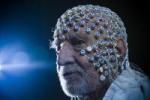Welcome to the Rousselet Lab
Fast visual processing research
In our lab we are trying to understand how fast visual processing of objects, faces and natural scenes is accomplished in the brain.
We study these processes using electroencephalography (EEG), a method which records electrical brain signals from the scalp with millisecond (ms) precision. In particular, we use event-related potentials (ERPs): EEG responses time-locked to sensory stimulation and averaged over hundreds or thousands of trials.
Many researchers are interested in what this EEG signal looks like, where the signals are in the brain, or examining changes in the timing of these signals. However, it is also important to understand what the message, or content of the signal, actually is. For example, if we see a face, what information about that face do our brains communicate? What information are our brains processing?
Recently, we have been trying to address these issues in a range of projects using a combination of techniques: Bubbles, Mutual Information and reverse correlation.
Quick links
- Help our research
- School of Psychology
- Postgraduate taught degrees
- Postgraduate research opportunities
Ageing research
The process of cerebral ageing affects not only higher level cognitive functions such as memory, but also quite basic visual processes like face detection or recognition. These processes are nevertheless quite important for daily social interaction.
Using EEG, we have previously shown that from the age of 20 to the age of 70, the speed with which our brains process faces slows down by about 50 ms, or 1 ms per year.
Currently, using a technique called ‘Bubbles’ we are trying to assess the functional interpretation of these changes, i.e. whether the delay arises because of a general slowing down across the brain, or is it because of a different processing of facial information by older adults specifically.

Find out more:
- links to ageing projects

